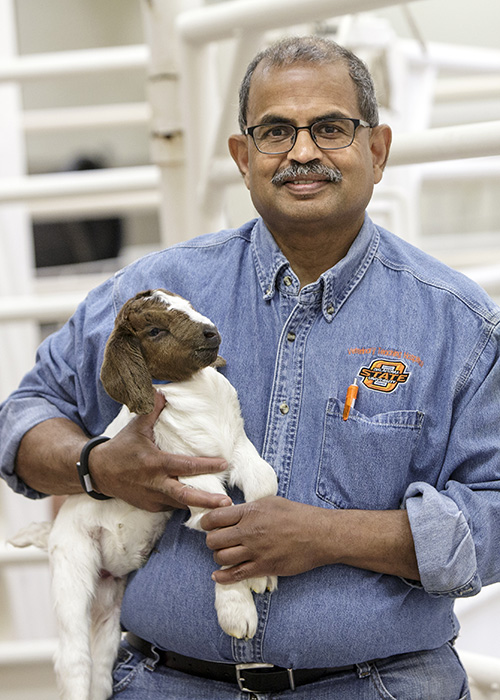
Protecting moms during lambing and kidding season
Monday, April 1, 2019
Spring brings lambing and kidding season. Monitoring pregnant does and ewes is critical for a better outcome for both mothers and babies.
During the last month of pregnancy, isolate these mothers and provide them with clean water and good quality hay and grain. Adding grain will help prevent pregnancy toxemia, ketosis and twinning disease. Does and ewes need to be vaccinated with Clostridium perfringens CD&T and dewormed three to four weeks before their kidding or lambing period. Not every doe or ewe needs to be dewormed; to see if yours do, look at the membranes around the eyeball, also known as FAMACHA scoring.
Monitor the mothers in labor to make sure the delivery progresses. Active labor signs include a pregnant animal down on her side, pushing or straining, with a fair amount of clear to bloody discharge from her vagina. She will be up and down, very restless. Does may vocalize a lot and frequently try to urinate. This stage lasts one to two hours. You should see feet or the head being pushed out. If this process is not progressing, help is needed.
If an ewe or doe is experiencing delivery problems:
• Isolate the animal: Place the ewe or doe in a relatively clean area, where her movement is restricted and separate from other members of the flock. If necessary, have someone assist in restraining the animal.
• Protection and cleanliness: Wash your hands thoroughly prior to examining the animal. Cut your fingernails short to avoid hurting her. Clean around the reproductive organs. Wear gloves to protect yourself; women should especially be cautious in this regard.
• Lubricate: Adequate lubrication is very important. Failure to lubricate the birth canal may cause tissue damage and undoubtedly a very difficult birth.
• Check for dilation: When you enter the vagina, keep your fingers close together to avoid injuring the reproductive tract. Locate the cervix and determine if it is dilated. If she is not fully dilated, give her more time and gently run your fingers around the cervix to expand the opening. If the cervix does not dilate after massaging the area, a caesarian section will be needed to save the mother and the baby. Do not try to pull the fetus with a partial dilation of the cervix.
• Determine the presentation of the fetus: If dilation has occurred, palpate the fetus to determine if it’s facing forward or backward. Distinguish between front and back legs and follow the legs to the body to ensure you are working with one baby and not two coming out at the same time.
• Determine the posture of the fetus: Next, determine if the legs and head are positioned normally — upright.
• Pull: Normally, there is no need to pull. However, it is useful to know how to pull a lamb/kid if necessary. Allow approximately 45 to 60 minutes to elapse after the water bag breaks before attempting to intervene. If no progress is made after this period, the baby may be too big for the mother’s pelvic size. Never rush pulling because further damage may be caused or even death to the mother and/or baby or babies.
• Call your veterinarian immediately if the mother is not progressing in labor, cervix is not dilated, more than two legs are felt in the vagina or the birth canal is too narrow for the baby to come out.
After lambs or kids are delivered, you can increase their chances of survival with these steps:
• Clean mucus and water bag from baby’s head with a piece of clean cloth.
• Clear mucus from around the lamb’s mouth and nose. Gently insert something such as a piece of straw a short distance into the nose to clear the nasal passage or induce it to sneeze.
• Gently swing the lamb by its back feet with one hand, stopping it abruptly with the other to increase air intake.
• Spray or dip the navel of newborn lambs/kids in a 7 percent tincture of iodine or another good drying agent to prevent navel illness.
• Place lamb/kid by its dam's head for her to clean the afterbirth. Do not remove the afterbirth because the ewe will use the scent to recognize her lamb/kid later.
• Check for other lambs/kids remaining in the ewe/doe. The second birth will generally require assistance even if the first birth did not. Allow approximately 30 to 45 minutes before trying to assist with the next lamb/kid.
• Check with your veterinarian regarding antibiotic therapy after a problem delivery. Most antibiotics available for food animal usage are not approved for sheep and goats, so get your veterinarian’s OK before using it off-label.
• Give the ewe or doe Oxytocin to help her pass her placenta, involute the uterus and prevent infection.
The first 18 hours after the birth is the most critical period. Place lambs/kids born in a warm, clean and dry pen with their dams. Lambing/kidding pens are preferred for the first 48 hours so the mother can bond with her baby. This allows newborns full access to colostrum to get the antibodies available for protection against diseases. If the lamb or kid is weak, colostrum should be given, via either a small feeding tube or bottle feeding. They need 15 percent of their body weight within 24 hours. Rule of thumb is 2 ounces/kg of body weight within 12 hours.
As a good precaution, clean up any afterbirth from the delivery site to reduce the possible spread of disease.
